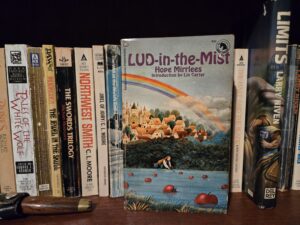
Lin Carter did readers a favor with his Adult Fantasy Series. It is unlikely I would have encountered Hope Mirrlees Lud-in-the-Mist without Ballantine’s unicorn head colophon.
Lud-in-the-Mist belongs to that select group of tales set on the bounds of faerie, along with Lord Dunsany’s The King of Elfland’s Daughter and Tolkien’s Smith of Wooton Major. In this genre of stories, the common lands that we know abut a forbidden — and thus enticing — realm of mystery; the home of elf, fairy, or perhaps even the dead. It is an enchanted place, full of promised wonder. And yet at the same time perilous. Passage from our world to the other is fraught with danger, or at least so holds prevailing folk wisdom.
Hope Mirrlees, despite the twee and charming depictions of her gorgeous prose, leans into the peril. Much as Tolkien did later in Smith, beneath the glamor and compelling temptations there lurks significant darkness. The faerie across the Elfin Hills bordering Dorimare is initially presented in the novel as a sort of whimsical place, the origin of mind-expanding fruits, of music and dance, and the source of unique colloquial expressions. But soon she adds the notion that the country people conflate fairies with the dead.
And when children begin consuming smuggled fairy fruit and head, dancing without cease, the fifty miles to the border, matters take a darker turn. Secrets are revealed. Old murders are revealed. Hangings — both judicial and self-imposed — occur. A complete societal upheaval follows.
The novel largely follows the wonderfully named Nathaniel Chanticleer, Mayor of Lud-in-the-Mist, the capitol of Dorimare, in his personal development. Originally portrayed as a rather vacant, amiable, respectable dullard, his underlying capacity for wonder expands. Driven largely by his realization of paternal love for his son (and his expulsion for office) he takes on the role of hero, doggedly pursuing his son when — late in the book — the lad crosses the border into fairy land. Revelations concerning faerie are few, and a reader who expects a sight seeing trip through the world of elves and sprites will disappointed. But the book is not about faerie, rather it is about the effect of living next to it, while deliberately attempting to collectively turn the back to it.
Mirrlees delves into concepts one might not expect in such a novel. The arbitrary, artificial nature of law. The necessity of art and poetry to balance a prosaic culture. She even appears to note a connection between art and mind altering chemistry (or magic.) And she offers no consolation: even with an admixture of childlike whimsy infused into a well-adjusted, rational mind such as Chanticleer’s: “Nor, I fear, did he cease to be the prey of melancholy. I doubt whether initiation ever brings happiness. It may be that the final secret revealed is a very bitter one…” For all the embroidered, fairy tale style of the prose, Mirrlees deftly ensures that a certain, grim fatalism remains lurking beneath the surface.
Lud-in-the-Mist is a slow, leisurely read, a nice change of pace from more action-oriented fare. If you are in the mood for it, settle in with a cup of tea (laced with something a bit stronger) and enjoy.
And after that, if you want something faster paced, pick up one of my Semi-Autos and Sorcery novels. You can start with Blood and Jade, though there’s no necessity to read them in order.
